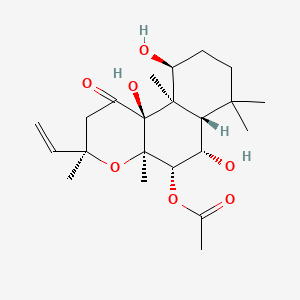| MeSH term | MeSH ID | Detail |
|---|---|---|
| Hemolysis | D006461 | 131 associated lipids |
| Diarrhea | D003967 | 32 associated lipids |
| Diabetes Mellitus | D003920 | 90 associated lipids |
| Hearing Loss, Sensorineural | D006319 | 8 associated lipids |
| Graft Occlusion, Vascular | D006083 | 11 associated lipids |
| Arrhythmias, Cardiac | D001145 | 42 associated lipids |
| Hypercalcemia | D006934 | 13 associated lipids |
| Neovascularization, Pathologic | D009389 | 39 associated lipids |
| Tumor Virus Infections | D014412 | 8 associated lipids |
| Adenocarcinoma | D000230 | 166 associated lipids |
forskolin
Forskolin is a lipid of Prenol Lipids (PR) class. Forskolin is associated with abnormalities such as Cholestasis, Vocal cord dysfunction familial, Hypothyroidism, Renal tubular disorder and Disintegration (morphologic abnormality). The involved functions are known as Cell Proliferation, Anabolism, mRNA Expression, Agent and Signal. Forskolin often locates in Extracellular, Body tissue, Skin, Tissue membrane and Membrane. The associated genes with forskolin are P4HTM gene, SLC33A1 gene, NR1I2 gene, Genes, Reporter and CYP3A gene. The related lipids are Steroids, steroid sulfate, Fatty Acids, LYSO-PC and Lipopolysaccharides.
Cross Reference
Introduction
To understand associated biological information of forskolin, we collected biological information of abnormalities, associated pathways, cellular/molecular locations, biological functions, related genes/proteins, lipids and common seen animal/experimental models with organized paragraphs from literatures.
What diseases are associated with forskolin?
forskolin is suspected in Cyst, Kozlowski Celermajer Tink syndrome, Vocal cord dysfunction familial, Alzheimer's Disease, Cholestasis, Renal tubular disorder and other diseases in descending order of the highest number of associated sentences.
Related references are mostly published in these journals:
| Disease | Cross reference | Weighted score | Related literature |
|---|
Possible diseases from mapped MeSH terms on references
We collected disease MeSH terms mapped to the references associated with forskolin
PubChem Associated disorders and diseases
What pathways are associated with forskolin
Lipid pathways are not clear in current pathway databases. We organized associated pathways with forskolin through full-text articles, including metabolic pathways or pathways of biological mechanisms.
Related references are published most in these journals:
| Pathway name | Related literatures |
|---|
PubChem Biomolecular Interactions and Pathways
Link to PubChem Biomolecular Interactions and PathwaysWhat cellular locations are associated with forskolin?
Visualization in cellular structure
Associated locations are in red color. Not associated locations are in black.
Related references are published most in these journals:
| Location | Cross reference | Weighted score | Related literatures |
|---|
What functions are associated with forskolin?
Related references are published most in these journals:
| Function | Cross reference | Weighted score | Related literatures |
|---|
What lipids are associated with forskolin?
Related references are published most in these journals:
| Lipid concept | Cross reference | Weighted score | Related literatures |
|---|
What genes are associated with forskolin?
Related references are published most in these journals:
| Gene | Cross reference | Weighted score | Related literatures |
|---|
What common seen animal models are associated with forskolin?
There are no associated biomedical information in the current reference collection.
NCBI Entrez Crosslinks
All references with forskolin
Download all related citations| Authors | Title | Published | Journal | PubMed Link |
|---|---|---|---|---|
| Kawabata H et al. | A HAMP promoter bioassay system for identifying chemical compounds that modulate hepcidin expression. | 2015 | Exp. Hematol. | pmid:25633564 |
| Kusama K et al. | Regulatory Action of Calcium Ion on Cyclic AMP-Enhanced Expression of Implantation-Related Factors in Human Endometrial Cells. | 2015 | PLoS ONE | pmid:26161798 |
| Na YR et al. | Endogenous prostaglandin E2 potentiates anti-inflammatory phenotype of macrophage through the CREB-C/EBP-β cascade. | 2015 | Eur. J. Immunol. | pmid:26118414 |
| Zhang Y et al. | Resveratrol improves hepatic steatosis by inducing autophagy through the cAMP signaling pathway. | 2015 | Mol Nutr Food Res | pmid:25943029 |
| Jóźwiak-Bębenista M et al. | The cyclic AMP effects and neuroprotective activities of PACAP and VIP in cultured astrocytes and neurons exposed to oxygen-glucose deprivation. | 2015 | Pharmacol Rep | pmid:25712659 |
| Tao H et al. | Cyclic AMP prevents decrease of phosphorylated ezrin/radixin/moesin and chloride intracellular channel 5 expressions in injured podocytes. | 2015 | Clin. Exp. Nephrol. | pmid:25725994 |
| Fuccelli R et al. | The hydroxytyrosol-dependent increase of TNF-α in LPS-activated human monocytes is mediated by PGE2 and adenylate cyclase activation. | 2015 | Toxicol In Vitro | pmid:25866079 |
| Mohan S et al. | Neuroprotective role of prostaglandin PGE2 EP2 receptor in hemin-mediated toxicity. | 2015 | Neurotoxicology | pmid:25451967 |
| Pavan B et al. | Quercetin and quercetin-3-O-glucoside interact with different components of the cAMP signaling cascade in human retinal pigment epithelial cells. | 2015 | Life Sci. | pmid:25476834 |
| Woodworth BA | Resveratrol ameliorates abnormalities of fluid and electrolyte secretion in a hypoxia-Induced model of acquired CFTR deficiency. | 2015 | Laryngoscope | pmid:25946147 |
